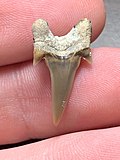Top Qs
Timeline
Chat
Perspective
Bladen Formation
Geologic formation in North Carolina From Wikipedia, the free encyclopedia
Remove ads
The Bladen Formation is a geologic formation from the Late Cretaceous (middle Campanian) of North Carolina and South Carolina, USA. It is known for a plethora of terrestrial and aquatic vertebrate fossils, including dinosaurs and mosasaurs.[1] It appears to be roughly concurrent with the Tuscaloosa Formation of Alabama.[2]
Unlike many other Cretaceous geologic formations from eastern North America, which were deposited in entirely marine environments, the Bladen Formation appears to have been deposited in a former river delta in an estuarine habitat, allowing for a mixture of freshwater, terrestrial, and marine fauna.[3] An important locality is the former Bladen County landfill annex in Elizabethtown, North Carolina, which contains the richest known fauna from the formation.[4][5] Another notable locality is near Quinby in Florence County, South Carolina, which also appears to have been deposited in a nonmarine environment with minor marine influence.[6]
It is deposited as a thin layer over the Tar Heel/Coachman Formation, which is often confused with. In North Carolina, it underlies the Maastrichtian-aged Peedee Formation, while in South Carolina it underlies the slightly younger Campanian-aged Donoho Creek Formation.[7]
Remove ads
Vertebrate paleobiota
Summarize
Perspective
Based on Crane (2011), Schwimmer et al (2015) and the Paleobiology Database:[3][6][8]
Cartilaginous fish
Based on Crane (2011) and Case et al (2019):[3][9]
The chondrichthyan biota closely resembles that of the Aguja Formation from Texas.[9]
Hybodonts
Sharks
Rays
Bony fish
Amphibians
Reptiles
Dinosaurs
Based on Brownstein (2018):[14]
Crocodylomorphs
Turtles
Plesiosaurs
Squamates
Mammals
Remove ads
See also
References
Wikiwand - on
Seamless Wikipedia browsing. On steroids.
Remove ads
































